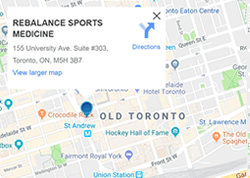How to Choose a Supportive Running Shoe
 Choosing a good quality running shoe that offers adequate support and allows for normal mobility of your feet is very important. The type of running shoe you wear will influence the mechanics of your foot and ankle, which in turn, can affect the muscles, joints, and ligaments of the kinetic chain above your feet including your knees, hips and low back.
Choosing a good quality running shoe that offers adequate support and allows for normal mobility of your feet is very important. The type of running shoe you wear will influence the mechanics of your foot and ankle, which in turn, can affect the muscles, joints, and ligaments of the kinetic chain above your feet including your knees, hips and low back.
Here are 4 basic and essential tests you can do in-store to help determine whether or not the shoe offers good motion control and flexibility to accommodate the foot as it propels your body through motion.
Torsional Rigidity (Dishrag Test)

Place one of your hands at the toe of the shoe and the other at the heel of the shoe. Twist the shoe in opposite directions. It is normal for the shoe to twist slightly, but if the shoe bends, twists, or buckles as if it were a dishrag, this shoe has poor motion control and fails this test.
Heel Counter Rigidity (Pinch Test)

With your thumb and index finger of the same hand, pinch the back of the heel just above the sole of the shoe. Ideally, the heel counter should be rigid to stabilize the rear-foot. If the heel counter feels soft or gives away, then the shoe probably does not provide enough hind foot and ankle support.
Flexion Stability (Fold Test)

Grab the toe of the shoe with one hand and the heel of the shoe with the other hand. Attempt to fold the shoe in half. The shoe should not fold in half. If the shoe folds in half, it provides poor stability in the mid-foot region. Ideally, it should fold at the ball of your foot to provide flexibility in the forefoot as well as to generate power for toe-off propulsion. If the shoe is too stiff and does not fold at all, this may result in fatigued muscles and shin splints since more force is required to bend the shoe.
Upper Stability (Shelf Test)
 This test only requires observation. Place both shoes on a shelf, heels facing you. Notice if the heels are slanting inwards or outwards. If they are tilted to one side, this puts your feet at a disadvantage from the start (please see diagram below). The heels should be standing vertical and symmetrical to each other, and not tilting to one side.
This test only requires observation. Place both shoes on a shelf, heels facing you. Notice if the heels are slanting inwards or outwards. If they are tilted to one side, this puts your feet at a disadvantage from the start (please see diagram below). The heels should be standing vertical and symmetrical to each other, and not tilting to one side.
Contact one of our orthotics specialists today to learn more about the importance of choosing the best fitting shoe for your feet!
Rebalance Toronto
Rebalance Sports Medicine is a multidisciplinary clinic in downtown Toronto offering physiotherapy, chiropractic, registered massage therapy, sports medicine, naturopathy, Pilates and more.



 What to Expect From Your First Physiotherapy Visit
What to Expect From Your First Physiotherapy Visit The Benefits of Fascial Stretch Therapy [Demo]
The Benefits of Fascial Stretch Therapy [Demo] How Does Physiotherapy Work?
How Does Physiotherapy Work? Best Exercises for Low Back Pain
Best Exercises for Low Back Pain